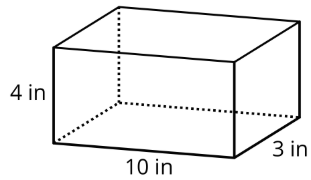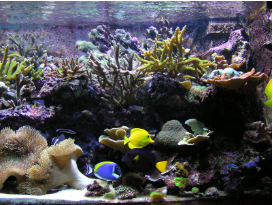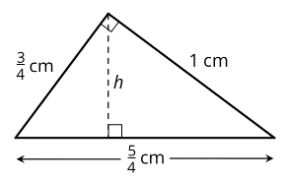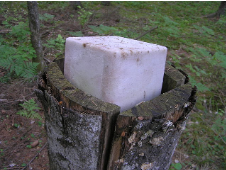24.4: Volume of Prisms
- Page ID
- 40248
Lesson
Let's look a the volume of prisms that have fractional measurements.
Exercise \(\PageIndex{1}\): A Box of Cubes
- How many cubes with an edge length of \(1\) inch fill this box?

- If the cubes had an edge length of \(2\) inches, would you need more or fewer cubes to fill the box? Explain your reasoning.
- If the cubes had an edge length of \(\frac{1}{2}\) inch, would you need more or fewer cubes to fill the box? Explain your reasoning.
Exercise \(\PageIndex{2}\): Cubes with Fractional Edge Lengths
- Diego says that 108 cubes with an edge length of \(\frac{1}{3}\) inch are needed to fill a rectangular prism that is 3 inches by 1 inch by \(1\frac{1}{3}\) inch.
- Explain or show how this is true. If you get stuck, consider drawing a diagram.
- What is the volume, in cubic inches, of the rectangular prism? Explain or show your reasoning.
- Lin and Noah are packing small cubes into a larger cube with an edge length of \(1\frac{1}{2}\) inches. Lin is using cubes with an edge length of \(\frac{1}{2}\) inch, and Noah is using cubes with an edge length of \(\frac{1}{4}\) inch.
- Who would need more cubes to fill the \(1\frac{1}{2}\)-inch cube? Be prepared to explain your reasoning.
- If Lin and Noah each use their small cubes to find the volume of the larger \(1\frac{1}{2}\)-inch cube, will they get the same answer? Explain or show your reasoning.
Exercise \(\PageIndex{3}\): Fish Tank and Baking Pan
- A nature center has a fish tank in the shape of a rectangular prism. The tank is \(10\) feet long, \(8\frac{1}{4}\) feet wide, and \(6\) feet tall.
- What is the volume of the tank in cubic feet? Explain or show your reasoning.

- The nature center's caretaker filled \(\frac{4}{5}\) of the tank with water. What was the volume of the water in the tank, in cubic feet? What was the height of the water in the tank? Explain or show your reasoning.
- Another day, the tank was filled with 330 cubic feet of water. The height of the water was what fraction of the height of the tank? Show your reasoning.
- Clare’s recipe for banana bread won’t fit in her favorite pan. The pan is \(8\frac{1}{2}\) inches by 11 inches by 2 inches. The batter fills the pan to the very top, and when baking, the batter spills over the sides. To avoid spills, there should be about an inch between the top of the batter and the rim of the pan.
Clare has another pan that is 9 inches by 9 inches by \(2\frac{1}{2}\) inches. If she uses this pan, will the batter spill over during baking?
Are you ready for more?
- Find the area of a rectangle with side lengths \(\frac{1}{2}\) and \(\frac{2}{3}\).
- Find the volume of a rectangular prism with side lengths \(\frac{1}{2}\), \(\frac{2}{3}\), and \(\frac{3}{4}\).
- What do you think happens if we keep multiplying fractions \(\frac{1}{2}\cdot\frac{2}{3}\cdot\frac{3}{4}\cdot\frac{4}{5}\cdot\frac{5}{6}\ldots\)?
- Find the area of a rectangle with side lengths \(\frac{1}{1}\) and \(\frac{2}{1}\).
- Find the volume of a rectangular prism with side lengths \(\frac{1}{1}\), \(\frac{2}{1}\), and \(\frac{1}{3}\).
- What do you think happens if we keep multiplying fractions \(\frac{1}{1}\cdot\frac{2}{1}\cdot\frac{1}{3}\cdot\frac{4}{1}\cdot\frac{1}{5}\ldots\)?
Summary
If a rectangular prism has edge lengths \(a\) units, \(b\) units, and \(c\) units, the volume is the product of \(a\), \(b\), and \(c\). \(V=a\cdot b\cdot c\)
This means that if we know the volume and two edge lengths, we can divide to find the third edge length.
Suppose the volume of a rectangular prism is \(400\frac{1}{2}\) cm3, one edge length is \(\frac{11}{2}\) cm, another is \(6\) cm, and the third edge length is unknown. We can write a multiplication equation to represent the situation: \(\frac{11}{2}\cdot 6\cdot ?=400\frac{1}{2}\)
We can find the third edge length by dividing: \(400\frac{1}{2}\div\left(\frac{11}{2}\cdot 6\right)=?\)
Practice
Exercise \(\PageIndex{4}\)
A pool in the shape of a rectangular prism is being filled with water. The length and width of the pool is 24 feet and 15 feet. If the height of the water in the pool is \(1\frac{1}{3}\) feet, what is the volume of the water in cubic feet?
Exercise \(\PageIndex{5}\)
A rectangular prism measures \(2\frac{2}{5}\) inches by \(3\frac{1}{5}\) inches by 2 inch.
- Priya said, “It takes more cubes with edge length \(\frac{2}{5}\) inch than cubes with edge length \(\frac{1}{5}\) inch to pack the prism.” Do you agree with Priya? Explain or show your reasoning.
- How many cubes with edge length \(\frac{1}{5}\) inch fit in the prism? Show your reasoning.
- Explain how you can use your answer in the previous question to find the volume of the prism in cubic inches.
Exercise \(\PageIndex{6}\)
- Here is a right triangle. What is its area?
- What is the height \(h\) for the base that is \(\frac{5}{4}\) units long? Show your reasoning.

(From Unit 4.4.3)
Exercise \(\PageIndex{7}\)
To give their animals essential minerals and nutrients, farmers and ranchers often have a block of salt—called “salt lick”—available for their animals to lick.
- A rancher is ordering a box of cube-shaped salt licks. The edge lengths of each salt lick are \(\frac{5}{12}\) foot. Is the volume of one salt lick greater or less than 1 cubic foot? Explain your reasoning.

- The box that contains the salt lick is \(1\frac{1}{4}\) feet by \(1\frac{2}{3}\) feet by \(\frac{5}{6}\) feet. How many cubes of salt lick fit in the box? Explain or show your reasoning.
Exercise \(\PageIndex{8}\)
- How many groups of \(\frac{1}{3}\) inch are in \(\frac{3}{4}\) inch?
- How many inches are in \(1\frac{2}{5}\) groups of \(1\frac{2}{3}\) inches?
(From Unit 4.4.1)
Exercise \(\PageIndex{9}\)
Here is a table that shows the ratio of flour to water in an art paste. Complete the table with values in equivalent ratios.
| cups of flour | cups of water |
|---|---|
| \(1\) | \(\frac{1}{2}\) |
| \(4\) | |
| \(3\) | |
| \(\frac{1}{2}\) |
(From Unit 2.4.2)

